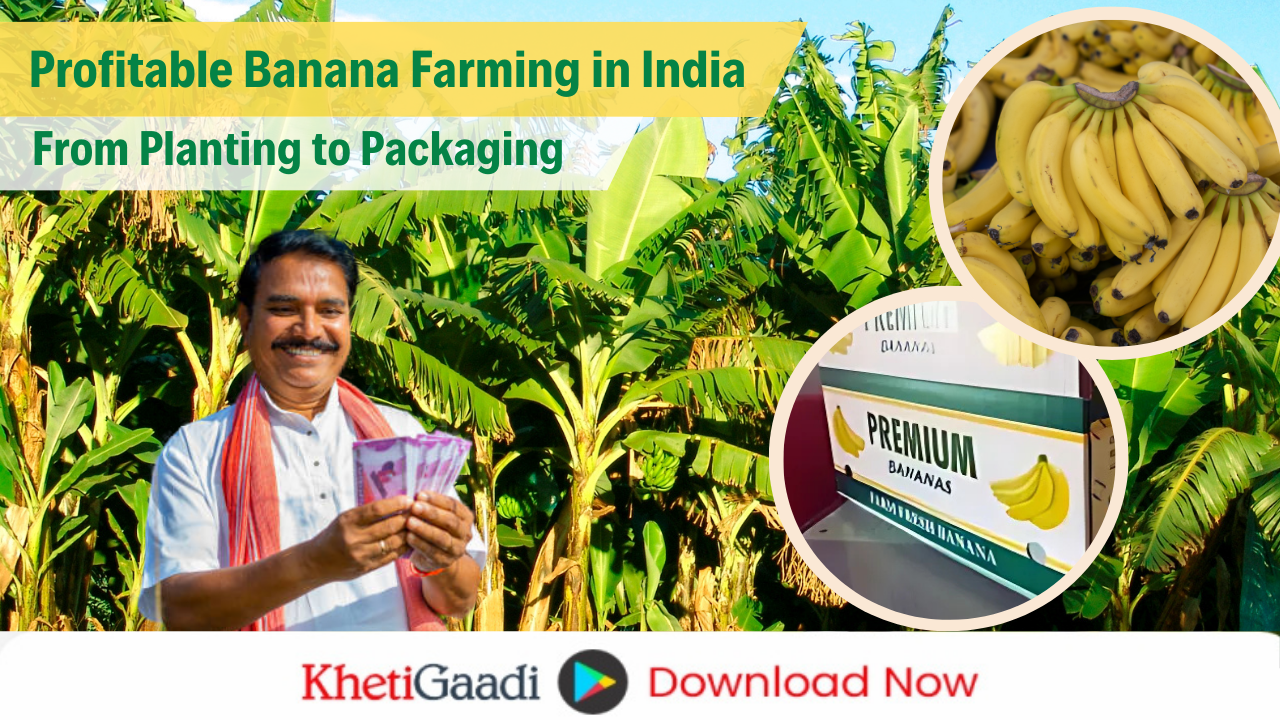Banana farming holds a significant place in Indian agriculture due to the crop’s economic value, nutritional benefits, and versatility. India is the largest producer of bananas in the world, accounting for about 25% of the global production. This tropical fruit is cultivated across various regions, contributing significantly to the livelihoods of millions of farmers. In this article, we will explore the importance of banana farming in India, suitable soil types, popular banana varieties, the process of banana cultivation, common diseases affecting the crop, and the steps involved in harvesting and packaging. Additionally, we’ll discuss banana crop duration and the yield farmers can expect from this highly profitable venture.
Importance of Banana Farming in India
Bananas are a staple food for millions of people in India, consumed as fresh fruit, processed into chips, purees, and even used in cooking. The banana plant itself holds cultural significance, with its leaves and fruit being used in religious ceremonies. Economically, bananas are a major source of income for farmers, especially in states like Maharashtra, Tamil Nadu, Gujarat, Andhra Pradesh, and Karnataka. Banana farming is highly profitable due to its year-round cultivation potential and high market demand, both domestically and internationally.
Suitable Soil Types for Banana Plantation
Bananas thrive in a wide range of soils but prefer deep, well-drained, loamy soils rich in organic matter. The ideal soil pH for banana cultivation ranges from 6 to 7.5. Key factors to consider when selecting soil for banana farming include:
- Drainage: Bananas are susceptible to waterlogging, so well-drained soil is essential.
- Fertility: High organic matter content in the soil promotes healthy plant growth. Adding organic manure or compost improves soil fertility.
- Soil Moisture: Bananas require a consistent supply of moisture for optimal growth, so soils that retain moisture but don’t become waterlogged are ideal.
Popular Banana Varieties in India
India is home to a wide range of banana varieties, each with unique characteristics suited for different climatic conditions and market demands.
Some of the most popular varieties include:
- Dwarf Cavendish: This variety is widely grown due to its high yield and suitability for export. The fruit is medium-sized, with a smooth texture and sweet taste.
- Robusta: Known for its tolerance to harsh conditions, this variety produces large bunches of bananas and is widely cultivated in southern India.
- Nendran: Grown primarily in Kerala, this variety is known for its thick skin and sweet flavour. It is often used for making banana chips.
- Rasthali: This variety has a distinct aroma and taste, making it a popular choice in South India. However, it is more susceptible to diseases compared to other varieties.
- Poovan: A popular variety in Tamil Nadu, Poovan bananas are small, sweet, and resistant to diseases like leaf spot and wilt.
- Grand Naine: A variant of Dwarf Cavendish, this variety is known for its uniform size, attractive appearance, and high export potential.
How to Grow Banana Crops
The process of cultivating bananas involves several steps, from planting to nurturing the crop for optimal yield.
1. Land Preparation
Bananas require well-prepared land for healthy growth. Farmers should plow the land thoroughly to remove weeds and loosen the soil. Organic manure, such as compost or cow dung, should be incorporated into the soil to enhance fertility. Raised beds or pits are often prepared to ensure good drainage.
2. Planting Material
Banana plants are propagated using suckers or tissue-cultured plants. Tissue-cultured plants are disease-free and provide uniform growth, making them a preferred choice for commercial farming.
- Suckers: These are offshoots of the mother plant and should be selected from healthy, disease-free plants.
- Tissue-Cultured Plants: These plants are grown in a lab and transplanted to the field. They offer better yield and are more resistant to diseases.
3. Planting Time
Bananas can be planted year-round in tropical regions, but the ideal time is during the onset of the monsoon season, when the soil moisture is adequate.
4. Spacing
Proper spacing between banana plants is crucial to ensure adequate air circulation and sunlight. Typically, plants are spaced 1.5 to 2 meters apart, with a row-to-row distance of 2.5 to 3 meters.
5. Irrigation
Bananas require frequent irrigation to maintain soil moisture. Drip irrigation is an efficient method, as it ensures that water reaches the root zone without wastage. Depending on the climate, irrigation should be provided every 3-7 days.
6. Fertilization
Bananas are heavy feeders and require a balanced supply of nutrients throughout their growth. Farmers should apply a combination of organic manure, nitrogen, phosphorus, and potassium to ensure healthy growth and higher yields.
Diseases Affecting Banana Crops
Bananas are susceptible to several diseases that can severely impact yield and crop quality. Common diseases include:
1. Panama Disease (Fusarium Wilt)
This soil-borne fungal disease causes wilting of the banana plant and leads to yellowing and collapse of the leaves. Panama disease is difficult to control, and affected plants should be destroyed to prevent the spread of the infection.
2. Sigatoka (Leaf Spot Disease)
This fungal disease causes dark spots on banana leaves, reducing the plant’s ability to photosynthesize. Fungicide sprays and proper spacing can help reduce the spread of Sigatoka.
3. Bunchy Top Virus
This virus causes the leaves to become small and bunched at the top of the plant, stunting its growth. Infected plants should be uprooted and destroyed to prevent transmission to healthy plants.
4. Black Leaf Streak (Black Sigatoka)
This disease affects the leaves, causing them to dry out and turn black. It can be controlled through proper field management and the use of fungicides.
Banana Crop Duration and Yield
Banana crops generally take 10-12 months to reach maturity, depending on the variety and environmental conditions. The crop is typically harvested 12-15 months after planting. Banana plants produce fruit once and then die, but new suckers can be used for future planting, making it a continuous cycle.
The yield of bananas depends on several factors, including the variety, soil fertility, irrigation, and disease management. On average, a well-maintained banana farm can yield between 30 to 40 tons per hectare annually. Dwarf Cavendish and Robusta varieties tend to have higher yields, making them popular among commercial farmers.
1. Harvesting
Bananas are harvested when the fruit is mature but still green. Farmers need to ensure that the fruit is properly sized, with a full, rounded appearance. Harvesting is done manually by cutting the banana bunches from the plant. Care must be taken to avoid bruising the fruit during the process.
2. Post-Harvest Handling
After harvesting, bananas are cleaned and sorted based on size and quality. They are then packed in boxes or crates for transportation. Proper post-harvest handling is essential to prevent damage and ensure that the fruit reaches the market in good condition.
3. Packaging
For export, bananas are packed in ventilated cardboard boxes lined with cushioning material to protect the fruit during transit. For the domestic market, bananas are often sold in loose bunches, but improved packaging techniques are being adopted to reduce post-harvest losses.
Government Schemes for Banana Farming
The Indian government supports banana farming through several schemes aimed at improving productivity, ensuring sustainability, and enhancing farmer income. Here are some key government initiatives for banana farmers:
1. National Horticulture Mission (NHM)
The NHM promotes the growth of horticultural crops, including bananas, by providing financial support for the establishment of nurseries, adoption of improved technologies, and integrated pest management. Banana farmers can benefit from subsidies for planting material, irrigation, and post-harvest management.
2. Mission for Integrated Development of Horticulture (MIDH)
This scheme encourages the development of banana farming by providing subsidies for tissue culture labs, setting up processing units, and promoting modern farming techniques. Under MIDH, farmers can avail up to 50% subsidies for establishing banana plantations and developing infrastructure for cold storage, packing, and transport.
3. National Agriculture Market (e-NAM)
This digital platform facilitates better price realization for farmers by creating a unified market for agricultural produce. Banana farmers can list their produce on e-NAM to reach a broader customer base and reduce dependence on middlemen.
4. Pradhan Mantri Krishi Sinchai Yojana (PMKSY)
PMKSY aims to increase agricultural productivity through efficient water usage. Banana farmers can benefit from the scheme’s micro-irrigation components, including drip and sprinkler systems, which are ideal for banana cultivation due to the crop’s high water requirements.
5. Agri-Clinics and Agri-Business Centres Scheme
This scheme offers financial assistance and technical training to farmers interested in banana cultivation. The objective is to enhance the productivity of banana farms by providing access to expert advice on disease management, modern techniques, and better post-harvest practices.
Success Stories in Banana Farming
1. The Story of Subhash Patil, Maharashtra
Subhash Patil, a progressive farmer from Jalgaon, Maharashtra, transformed his traditional farming practices by shifting to high-density banana farming using the Grand Naine variety. He adopted tissue culture plants and invested in a drip irrigation system, leveraging government subsidies from the MIDH scheme. Over the years, Subhash increased his yield significantly, producing over 45 tons of bananas per hectare. His success story is a testament to the benefits of modern farming techniques, with Subhash earning ₹15-₹20 lakhs annually from his banana farm.
2. The Story of Suma Reddy, Karnataka
Suma Reddy, a farmer from Karnataka, started banana farming on a small scale with the Robusta variety. She received training on disease management under the National Horticulture Mission and used subsidies to install a micro-irrigation system. By utilizing organic farming practices, Suma not only increased her farm’s productivity but also supplied premium-quality bananas to the local markets. Today, Suma is recognized for her sustainable farming methods, earning a consistent income and mentoring other farmers in the region.
Conclusion
Banana farming in India is a lucrative venture with immense potential for growth. The country’s favourable climate, wide variety of banana species, and increasing demand make it an ideal crop for farmers looking to enhance their income. By choosing the right variety, adopting proper cultivation practices, and managing diseases effectively, farmers can achieve high yields and profitability. With the right support and modern techniques, banana farming will continue to thrive as a cornerstone of Indian agriculture.
Relevant Links
- National Horticulture Mission: http://nhm.nic.in
- Mission for Integrated Development of Horticulture (MIDH): https://midh.gov.in
- National Agriculture Market (e-NAM): https://www.enam.gov.in
- Pradhan Mantri Krishi Sinchai Yojana: https://pmksy.gov.in
- Agri-Clinics and Agri-Business Centres Scheme: https://agricoop.nic.in/agri-clinics-and-agri-business-centres




